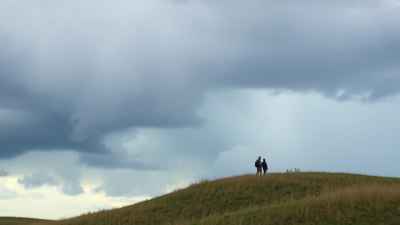Some People Are Basically Walking Cold Fronts
Explore how certain individuals' personalities and moods resemble walking cold fronts and impact social environments.

Image by Freepik
The phenomenon of certain individuals being likened to walking cold fronts is a fascinating comparison that draws from meteorology to describe human behavior and interpersonal dynamics. A cold front in meteorological terms is the boundary of an advancing mass of cold air, often marked by a sudden drop in temperature, shifting winds, and sometimes stormy weather. When we say some people are "basically walking cold fronts," we imply that their presence can bring a noticeable chill to the atmosphere around them, affecting moods, energy levels, and social climates.
This metaphor offers a framework for understanding why certain personalities seem to bring an abrupt shift in emotional or social ambiance, much like a cold front changes weather patterns. In this article, we will explore the origins of this analogy, the psychological and social dynamics behind it, and how to handle interactions with these "walking cold fronts" effectively.
Understanding the Cold Front Metaphor
To appreciate why some people are likened to walking cold fronts, it helps to first understand what a cold front is and how it affects its environment. A cold front occurs when a cold air mass moves into an area occupied by warmer air. The denser cold air pushes underneath the warmer air, forcing it upward. This lifts the warm air, cooling it and often leading to cloud formation, rain, or thunderstorms. Once the cold front passes, the temperature drops, the air clears, and the weather tends to settle into cooler, drier conditions.
When applied metaphorically to people, a walking cold front is someone whose presence dramatically shifts the emotional climate. They may bring a sense of discomfort, tension, or unease, often without any overt intention to do so. Their demeanor, energy, or even body language might create a social "temperature drop" that alters how others feel or behave in their presence.
Characteristics of a Walking Cold Front
People who personify walking cold fronts often share several distinct characteristics. These traits contribute to their ability to change the "weather" of a social setting.
1. Emotional Coolness: Such individuals may come across as emotionally reserved or detached. They might maintain a stoic expression, show minimal warmth in their tone, or avoid expressing enthusiasm. This emotional coolness can be misinterpreted as disinterest or aloofness.
2. Abrupt Interactions: Similar to how a cold front advances swiftly, these people may engage abruptly in conversations or social situations. They might introduce critical remarks or corrections sharply, causing others to feel taken aback or defensive.
3. Practicality and Realism: Walking cold fronts often prioritize facts and logic over emotional considerations. Their focus on realistic, sometimes blunt communication can feel like a gust of chilly wind that disrupts more emotive or idealistic conversations.
4. Energy Drain: Just as a cold front can sap the warmth from the air, these individuals sometimes inadvertently deplete the positive energy of a group. Their skepticism or negativity can lower morale or enthusiasm in social settings.
The Psychological Basis of "Walking Cold Fronts" Personalities
Psychologists approach this phenomenon by examining temperament, mood disorders, and personality traits. Several psychological constructs explain why some people manifest cold front-like tendencies.
Introversion and Emotional Regulation: Introverted individuals often prefer internal reflection over expressive interaction. While introversion itself isn't inherently "cold," some introverts may come off as emotionally cool, which can feel like the chill of a cold front.
Negative Affectivity and Mood Disorders: People with higher levels of negative affectivity—tending to experience negative emotions such as anger, sadness, or anxiety more frequently—may unconsciously emit a brooding or tense energy. Those with depression or anxiety disorders might appear distant or withdrawn, adding to the cold front effect.
High Standards and Critical Thinking: Individuals with perfectionist traits or strong critical thinking skills sometimes prioritize correctness and precision over empathy in communication. Their exacting nature can cause social discomfort resembling a sudden cold snap.
Social Dynamics and Impact
In social groups, the presence of a walking cold front can have various impacts.
Disrupting Group Cohesion: Their blunt or critical behavior can interrupt the flow of conversation and challenge group harmony. While constructive criticism is valuable, the way it’s delivered makes the difference between fostering growth and chilling group warmth.
Creating Distance or Misunderstandings: Emotional coolness can lead to misunderstandings, as others may interpret it as disinterest or hostility. This can increase social distance and reduce trust.
Forcing Adaptation and Growth: Not all effects are negative. The presence of a walking cold front can prompt others to adjust their behavior, clarify intentions, or engage in deeper, more analytical conversations.
Dealing with Walking Cold Fronts in Personal and Professional Life
Recognizing the impact of these personalities is the first step toward effective interaction. Here are strategies for dealing with people who act like walking cold fronts.
Practice Empathy: Understand that their cold demeanor may stem from personality traits or psychological challenges rather than a desire to alienate others.
Communicate Clearly: Express your feelings openly but calmly. Use "I" statements to avoid putting them on the defensive.
Set Boundaries: If their behavior becomes too draining or negative, it’s important to establish limits on how much time or energy you invest in the interaction.
Acknowledge Positives: Identify and affirm the strengths and contributions of these individuals, such as their honesty or analytical skills. This can build rapport and reduce tension.
Walking Cold Fronts in Literature and Culture
The metaphor of a walking cold front extends beyond casual conversation into literary and cultural realms. Many characters in novels and films embody this archetype.
The Stoic Protector: Characters who are emotionally reserved but reliable and strong often have cold front-like qualities. They might not express warmth openly but act decisively in crises, their presence shifting the emotional atmosphere.
The Cynical Realist: These characters bring a sobering perspective to otherwise optimistic settings, much like a cold front dispels heat and humidity. Their cynicism can serve as a foil to more idealistic characters, introducing complexity.
The Social Outsider: Individuals who are marginalized or misunderstood often return to this metaphor because their social detachment resembles the isolating chill a cold front brings.
Scientific Analogies and Further Reflections
Beyond meteorology, the walking cold front metaphor parallels concepts in social psychology, such as emotional contagion and social thermoregulation.
Emotional contagion is the phenomenon where one person’s emotions and related behaviors directly trigger similar emotions and behaviors in others. This suggests walking cold fronts might lower group warmth not just by their behavior but by influencing the group’s overall emotional state.
Social thermoregulation describes how groups or individuals regulate their emotional states to maintain psychological comfort. The arrival of a walking cold front disturbs this equilibrium, necessitating adaptive responses.
Understanding these scientific principles highlights the involuntary nature of some cold front-like behavior and suggests empathy and strategic interaction over confrontation.
Personal Stories and Anecdotes
Many people can recall experiences with walking cold fronts in their lives. They remember how certain individuals could silence a room with a look or change the tone of a meeting in an instant.
One recounts a colleague who was so blunt and critical that new team members often felt intimidated. However, over time, the team learned that his critiques, though chilly, pushed them toward excellence and accountability.
Another story involves a family member described as emotionally distant. While this created tension, understanding the person's upbringing and insecurities helped others soften their perceptions and fostered better communication.
Adapting to and Leveraging Walking Cold Fronts
Rather than simply enduring the chill, it is possible to adapt to and even leverage the presence of walking cold fronts.
Build Emotional Resilience: Strengthening one’s capacity to remain calm and positive around emotionally cool individuals reduces the impact of their cold front effect.
Use the Coolness Constructively: In contexts requiring critical analysis, problem-solving, or crisis management, walking cold fronts can provide clarity and rationality free from excessive emotional bias.
Create Balanced Groups: Combining walking cold fronts with more emotionally warm personalities can create dynamic, balanced teams where different perspectives are valued and temperaments complement each other.
Recognizing when to lean into the rational coolness and when to seek warmth in social interactions is key to maintaining healthy relationships and effective communication.
Shifts in Contemporary Culture
Modern society increasingly values emotional intelligence and warmth, often framing emotional coolness negatively. However, understanding the value and function of walking cold fronts reframes this narrative.
In highly stressful or chaotic environments, the calm, cool presence can stabilize others. In leadership, a walking cold front personality might make tough decisions without succumbing to emotional pressure.
This shift encourages appreciating diverse emotional styles and learning to benefit from, rather than fight against, the different "weather patterns" in human behavior.
Moreover, as awareness of mental health grows, what was once seen purely as coldness may be better understood as a symptom of anxiety, depression, or neurodivergence, further deepening empathy.
The Role of Environment in Shaping Cold Front Behavior
It’s important to consider how environments affect whether a person appears like a walking cold front. High stress, trauma, or unsupportive settings can cause individuals to adopt defensive, cold postures as protective mechanisms.
Conversely, warmer, accepting environments can draw out more warmth from these individuals, tempering the cold front effect. Context thus plays a critical role in how personality traits manifest socially.
This interplay suggests that no one is purely a walking cold front but rather exhibits these qualities situationally, emphasizing flexibility and growth over fixed labeling.
Conclusion
In sum, describing some people as walking cold fronts offers a vivid metaphor for understanding certain social and emotional dynamics. These individuals, characterized by emotional coolness, bluntness, and pragmatic realism, alter the climate of interpersonal settings in ways both challenging and potentially beneficial.
By recognizing the psychological roots, social effects, and adaptive strategies related to walking cold fronts, we can better navigate our relationships and interactions. Embracing the diversity of emotional expression, including the chill of a cold front, enriches our social ecosystems and fosters deeper understanding.
The metaphor also invites us to reflect on how we respond to different emotional climates and how we might act as warm fronts ourselves, balancing and harmonizing the social atmosphere wherever we go.











